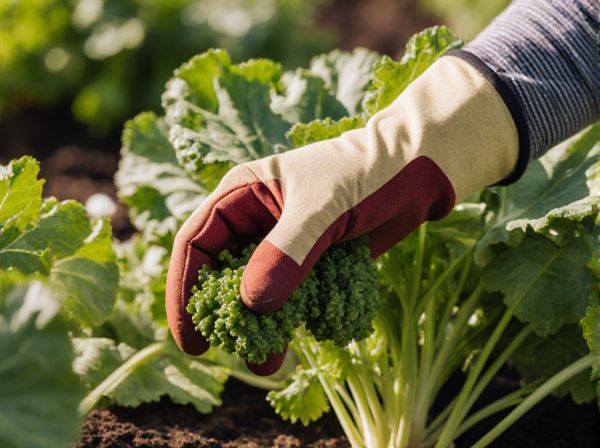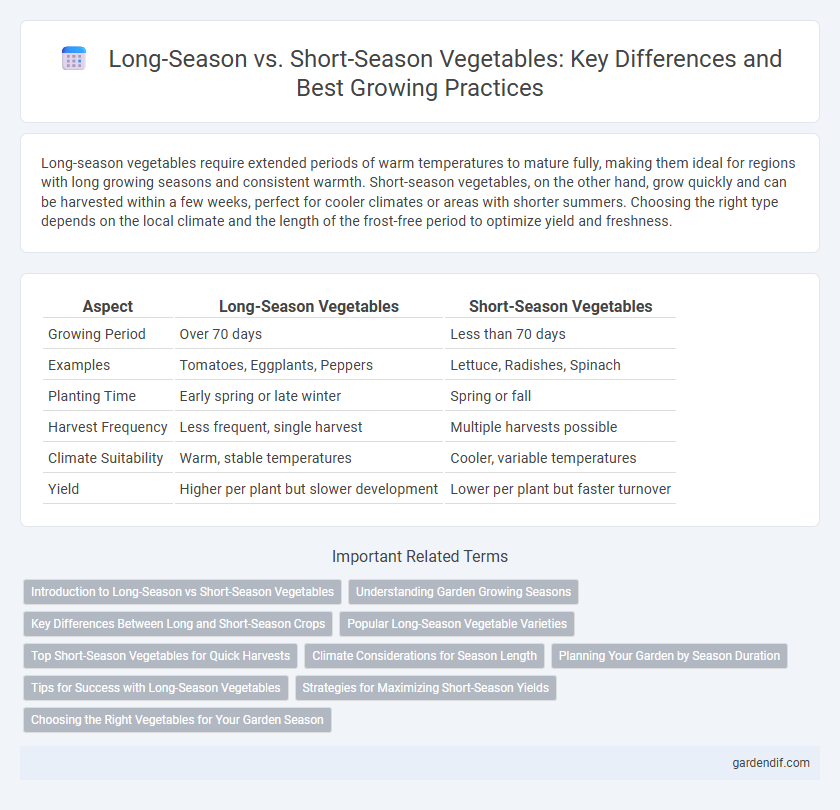
Long-season vegetables vs Short-season vegetables Illustration
Long-season vegetables require extended periods of warm temperatures to mature fully, making them ideal for regions with long growing seasons and consistent warmth. Short-season vegetables, on the other hand, grow quickly and can be harvested within a few weeks, perfect for cooler climates or areas with shorter summers. Choosing the right type depends on the local climate and the length of the frost-free period to optimize yield and freshness.
Table of Comparison
| Aspect | Long-Season Vegetables | Short-Season Vegetables |
|---|---|---|
| Growing Period | Over 70 days | Less than 70 days |
| Examples | Tomatoes, Eggplants, Peppers | Lettuce, Radishes, Spinach |
| Planting Time | Early spring or late winter | Spring or fall |
| Harvest Frequency | Less frequent, single harvest | Multiple harvests possible |
| Climate Suitability | Warm, stable temperatures | Cooler, variable temperatures |
| Yield | Higher per plant but slower development | Lower per plant but faster turnover |
Introduction to Long-Season vs Short-Season Vegetables
Long-season vegetables, such as tomatoes and pumpkins, require extended periods of warm temperatures and a longer growing cycle typically exceeding 100 days. Short-season vegetables, including radishes and lettuce, mature quickly within 30 to 60 days, making them ideal for climates with brief growing seasons. Understanding the difference between these vegetable types helps optimize planting schedules and maximize harvest yields based on regional weather conditions.
Understanding Garden Growing Seasons
Long-season vegetables such as tomatoes, peppers, and eggplants require extended warm temperatures and typically take 70 to 100 days or more to mature, making them ideal for late spring planting and summer harvests. Short-season vegetables like lettuce, radishes, and spinach mature quickly, often within 30 to 50 days, allowing for multiple successive plantings in a single growing season. Understanding garden growing seasons helps gardeners select crops matched to their climate's frost dates and temperature ranges, optimizing yield and reducing crop stress.
Key Differences Between Long and Short-Season Crops
Long-season vegetables such as tomatoes, peppers, and eggplants require more than 70 days to reach maturity, thriving in extended warm growing periods. Short-season vegetables like radishes, lettuce, and spinach mature within 30 to 50 days, allowing for multiple harvests in a single growing season. The key difference lies in their growth duration and temperature tolerance, influencing planting schedules and crop rotation planning for optimal yield.
Popular Long-Season Vegetable Varieties
Popular long-season vegetable varieties include tomatoes, eggplants, and sweet potatoes, which thrive in warm temperatures and require extended growing periods of 70 to 120 days. These crops benefit from steady heat and consistent moisture, making them ideal for regions with prolonged frost-free intervals. Gardeners often prioritize these vegetables for their robust yields and rich, mature flavors developed over the extended growth cycle.
Top Short-Season Vegetables for Quick Harvests
Short-season vegetables such as radishes, lettuce, and spinach mature rapidly within 30 to 45 days, enabling multiple harvests during a single growing season. These crops thrive in cooler temperatures and are ideal for gardeners seeking quick yields and continuous fresh produce. Prioritizing short-season vegetables allows efficient use of garden space and maximizes productivity in limited growing periods.
Climate Considerations for Season Length
Long-season vegetables such as tomatoes, melons, and eggplants require extended periods of warm temperatures and stable climate conditions to reach full maturity, making them suitable for regions with long growing seasons and minimal risk of early frost. Short-season vegetables like radishes, lettuce, and spinach thrive in cooler climates with shorter frost-free periods, allowing for multiple harvests within limited growing windows. Climate considerations such as average temperature, frost dates, and sunlight duration critically influence the successful cultivation and harvest timing of long-season versus short-season vegetables.
Planning Your Garden by Season Duration
Long-season vegetables such as tomatoes, peppers, and eggplants require extended growing periods, often ranging from 70 to 120 days, making them ideal for gardens with long frost-free seasons. Short-season vegetables like radishes, lettuce, and spinach mature rapidly, typically within 20 to 40 days, allowing for multiple harvests or succession planting in cooler climates with shorter growing windows. Planning your garden by season duration ensures optimal crop selection, maximizes yield potential, and minimizes the risk of frost damage.
Tips for Success with Long-Season Vegetables
Long-season vegetables such as tomatoes, eggplants, and peppers require consistent warmth and extended growing periods to reach full maturity. To ensure successful cultivation, choose heat-tolerant varieties, start seeds indoors early, and provide ample water and nutrient-rich soil throughout the season. Implementing row covers or greenhouses can extend the growing season and protect plants from unexpected cold snaps.
Strategies for Maximizing Short-Season Yields
Short-season vegetables require strategic planting schedules to maximize yield within limited growth periods, often benefiting from succession planting and compact, fast-maturing varieties. Utilizing season extension methods such as row covers, cold frames, and high tunnels can protect crops from early frost and extend harvest windows. Optimizing soil fertility and moisture retention further supports vigorous growth, ensuring robust yields despite the shorter growing season.
Choosing the Right Vegetables for Your Garden Season
Long-season vegetables such as tomatoes, peppers, and eggplants require extended growing periods of 70 to 100 days, ideal for warm climates with long summers. Short-season vegetables like lettuce, radishes, and spinach mature quickly within 30 to 50 days, making them perfect for cooler climates or early planting. Selecting the right vegetables based on your garden's season length enhances growth success and maximizes harvest yield.
Long-season vegetables vs Short-season vegetables Infographic

 gardendif.com
gardendif.com